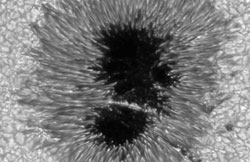Meteorites record past solar activity

A sunspot the size of the Earth. Sunspots result from the solar magnetic activity. Credit: Max Planck Institute for Solar System Research, Dr. Vasily Zakharov. Image taken with the Swedish Solar Telescope on the island of La Palma.
They compare the amount of Titanium 44 in nineteen meteorites that have fallen to the Earth over the past 240 years. Their work confirms that the solar activity has increased strongly during the 20th century. They also find that the Sun has been particularly active in the past few decades.
I. Usoksin and his colleagues have used meteorites to reconstruct past solar activity. Studying the earlier activity of our Sun is one of the oldest astrophysical projects, as astronomers began recording the number of sunspots to trace the Sun's magnetic activity four hundred years ago.
The international team examined a set of nineteen meteorites whose dates of fall are precisely known, and measured the amount of radioactive isotope Titanium 44 in these meteorites. Titanium 44 is produced by the cosmic rays in the meteorites while they are outside the Earth’s atmosphere. After the meteorite has fallen, it stops producing this isotope. By measuring the Titanium 44 in these meteorites, they are able to determine the level of solar activity at the time the meteorite fell.
Past solar activity is reconstructed with this technique in an independent way, that is, one not affected by terrestrial effects. How high the solar activity was at a given epoch was previously known from measuring the concentration of cosmogenic isotopes produced at that time. But most of the isotopes found on the Earth – in Greenland and Antarctic ice sheets or in tree rings, for instance – are also affected by terrestrial processes, in these examples related to the Earth’s magnetic field and climate. Until now, reconstructing past solar activity was thus very uncertain. This is shown by how various reconstructions that were previously published differ from one other. In the new study to be published this week in Astronomy & Astrophysics Letters, the team shows that the Sun is currently particularly active compared to earlier centuries.
[1] The team includes N. Bhandary (Basic Sciences Research Institute, Ahmedabad, India), G.A. Kovaltsov (Ioffe Physical-technical Institute, St. Petersburg, Russia), S.K. Solanki (Max-Planck Institute for Solar System Research, Katlenburg-Lindau, Germany), C. Taricco (Istituto Nazionale di Fisica Nucleare, Torino, Italy) and I.G. Usoskin (University of Oulu, Finland).
Media Contact
All latest news from the category: Physics and Astronomy
This area deals with the fundamental laws and building blocks of nature and how they interact, the properties and the behavior of matter, and research into space and time and their structures.
innovations-report provides in-depth reports and articles on subjects such as astrophysics, laser technologies, nuclear, quantum, particle and solid-state physics, nanotechnologies, planetary research and findings (Mars, Venus) and developments related to the Hubble Telescope.
Newest articles

Sea slugs inspire highly stretchable biomedical sensor
USC Viterbi School of Engineering researcher Hangbo Zhao presents findings on highly stretchable and customizable microneedles for application in fields including neuroscience, tissue engineering, and wearable bioelectronics. The revolution in…

Twisting and binding matter waves with photons in a cavity
Precisely measuring the energy states of individual atoms has been a historical challenge for physicists due to atomic recoil. When an atom interacts with a photon, the atom “recoils” in…

Nanotubes, nanoparticles, and antibodies detect tiny amounts of fentanyl
New sensor is six orders of magnitude more sensitive than the next best thing. A research team at Pitt led by Alexander Star, a chemistry professor in the Kenneth P. Dietrich…





















